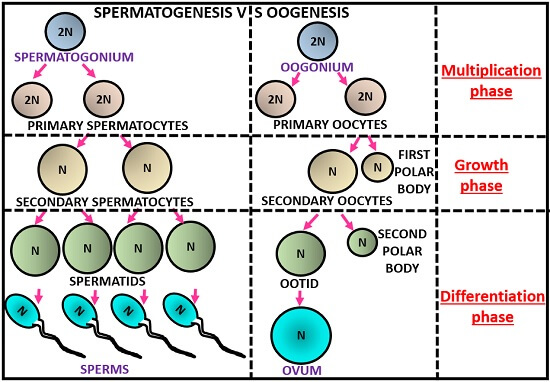Oogenesis And Spermatogenesis In Terms Of Meiosis?
Chromosomes through meiosis in order to create haploid gametes. Both oogenesis and spermatogenesis occur in separate locations in the body, although they share many commonalities. The main difference between oogenesis and spermatogenesis is that oogenesis occurs solely in women, whereas spermatogenesis occurs solely in men.
This is because women have XX chromosomes and men have XY chromosomes. Moreover, during spermatogenesis, haploid immature germ cells undergo meiosis to create spermatozoa with half the chromosome number (i.e., only one copy of each chromosome). In contrast, during oogenesis, haploid primary follicle cells undergo meiosis to create egg yolk-containing secondary follicles with half the chromosome number (i.e., only one copy of each chromosome).
What Is Oogenesis?
Oogenesis is triggered by FSH, or follicle-stimulating hormone, and LH, or luteinizing hormone, and it involves the meiotic division of oogonia. Oogonia usually become primary oocytes in the fetal stage, but they can become activated oocytes in the number of oocytes is reduced due to premature ovarian failure. Primary oocytes are arrested in prophase I of the first meiotic division, which takes place in a region of the ovaries called the primary follicle.
They remain in this state until ovulation when the primary oocyte completes its first meiotic division to produce an ovum or egg, and a second polar body. Secondary oocytes become mature oocytes in the post-ovulatory phase of the menstrual cycle.
What is Spermatogenesis?
spermatozoa are produced by growing and dividing within the seminiferous tubules of the testicles. It begins at puberty and ends during advanced age. It is triggered by hormones, such as FSH and LH, and it involves the meiotic division of spermatogonia.
Spermatogonia usually become primary spermatocytes in the fetal stage, but they can become activated spermatocytes if the number of spermatogonia is reduced due to premature gonadal failure. Primary spermatocytes are arrested in prophase I of the first meiotic division, which takes place in a region of the testicles called the germinal epithelium. They remain in this state until ejaculation when the primary spermatocytes complete their first meiotic division to produce haploid spermatozoa with one copy of each chromosome.
Main Differences Between Oogenesis And Spermatogenesis
The main difference between oogenesis and spermatogenesis is that oogenesis occurs solely in women, whereas spermatogenesis only occurs in men. This is because women have two X chromosomes and men have an X and a Y chromosome. During spermatogenesis, haploid immature germ cells undergo meiosis to create spermatozoa with half the chromosome number (i.e., only one copy of each chromosome).
In contrast, during oogenesis, haploid primary oocytes undergo meiosis to create an ovum with half the chromosome number (i.e., only one copy of each chromosome). Another difference between oogenesis and spermatogenesis is that spermatogenesis occurs in the seminiferous tubules of the testicles, while oogenesis occurs in the ovaries.
The main difference between oogenesis and spermatogenesis is that oogenesis occurs solely in women, whereas spermatogenesis only occurs in men. This is because women have two X chromosomes and men have an X and a Y chromosome.
During spermatogenesis, haploid immature germ cells undergo meiosis to create spermatozoa with half the chromosome number (i.e., only one copy of each chromosome). In contrast, during oogenesis, haploid primary oocytes undergo meiosis to create an ovum with half the chromosome number (i.e., only one copy of each chromosome).
Spermatogenesis occurs in the seminiferous tubules of the testicles, while oogenesis occurs in the ovaries. Another difference between oogenesis and spermatogenesis is that spermatogenesis occurs in the seminiferous tubules of the testicles, while oogenesis occurs in the ovaries.
Meiosis is a type of cell division that takes place in the ovaries and testes of humans and other animals. During this process, the chromosomes from each parent are split into halves and then recombined so that offspring have only half of the normal number of chromosomes.
Meiosis is a type of cell division that reduces the number of chromosomes from double to single copy again. In spermatogenesis, this occurs once more time because there are two haploid phases: pachytene and diploid.
The first one happens before the cell division and involves recombination between non-sister chromatids at broad regions; after that, during diploidy, recombination happens at narrow regions called ends, leading to four different haploid products all with different combinations of parental alleles within them.
In oogenesis, on the other hand, there are three haploid phases: pro-oogenesis (when nurse cells become oogonia), meiosis I (when communication is established between nearby XX sister chromatids), and meiosis II (the actual reduction from double
Differences between spermatogenesis and oogenesis in terms of meiosis
The process of spermatogenesis happens in the seminiferous tubules of the testes and takes about 64 days from start to finish. This process starts with stem cells that then become a type of immature cells called primary spermatocytes. The primary spermatocytes then move to the Golgi Apparatus, where they mature into secondary spermatocytes.
Finally, the secondary spermatocytes complete their meiosis and become spermatids, which are ready to be released into the epididymis. The spermatids stay in the epididymis for about a week and then are transferred to the vas deferens and ejaculatory ducts, ready to be ejaculated out of the body through the urethra.




